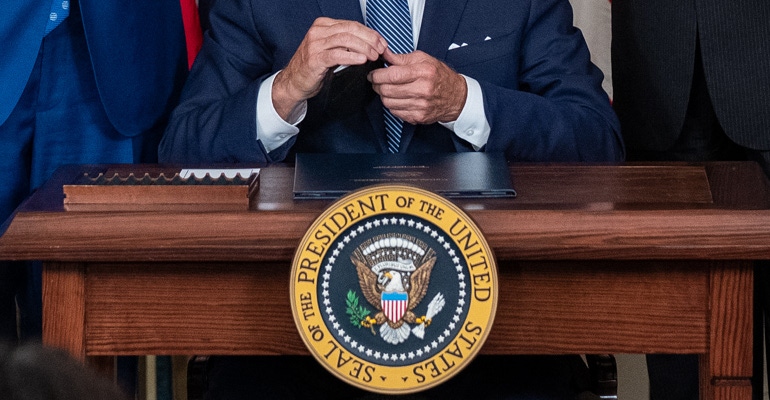The Battery Industry’s Top IRA Questions, Answered
These 10 questions, answered by a panel of experts, work through what battery makers need to understand about IRA funding.
September 15, 2023

With the seemingly daily news of billions of federal government dollars being appropriated, designated, and most importantly, awarded, the battery industry has—or should have—questions about how to understand and leverage Inflation Reduction Act (IRA) opportunities. To answer their concerns, a conference session panel on Sept. 12 was held at The Battery Show North America, specifically posing and answering, “The Top 10 Questions Industry Leaders Are Asking (Or Should Be Askling) About the IRA.”
The discussion was moderated by Chris Caputo, manufacturing initiative leader and partner at law firm Baker Donelson, Nashville, TN; with panelists Tom Schaefer, vice president, global lithium business at battery recycler Ecobat, Dallas, TX; and attorney Robert Gardner, vice president at Boundary Stone Partners, Washington, DC. Here are the questions and a summary of the panel’s responses:
Should recycling activities fall within the Inflation Reduction Act in the first place?
“Yes, next question,” Schaefer answered with a smile, noting that battery recycling was an essential component to the life cycle and related cost of lithium-ion batteries. “It drives a closed-loop ecosystem for domestic battery materials that reduces global supply chain requirements.”
As a manufacturer, what IRA tax credits should I be focusing on?
Gardner replied with sections 45X Advanced Manufacturing Production Credit and 48C Advanced Energy Product Credit. The Inflation Reduction Act creates a new production tax credit for domestic manufacturing of components along the supply chain for solar modules, wind turbines, battery cells and modules and critical minerals processing. The IRA also provides the Secretary of the Treasury with new authority to allocate $10 billion to projects that:
Re-equip, expand, or establish an industrial or manufacturing facility for the production or recycling of a range of renewable energy and energy-efficiency equipment, carbon-capture equipment, and advanced vehicles;
Re-equip an industrial or manufacturing facility with equipment designed to reduce greenhouse gas emissions by at least 20 percent; or
Re-equip, expand, or establish an industrial facility for the processing, refining, or recycling of critical materials.
That said, there are registration processes and many stipulations to be aware of, including the difference between utilizing tax credits (45X) and applying for grant money (48C).
Why do consumer credits matter to manufacturers?
Manufacturers will need to pay attention to reporting guidelines in the Clean Vehicle Credit (30D) and the Credit for Qualified Commercial Vehicles (45W), Gardner replied. To qualify for the maximum $7,500 Clean Vehicle Credit, the vehicle must meet certain standards for North American assembly; the battery’s components must meet certain standards for manufacturing or assembly; and the battery’s critical minerals must meet certain requirements for sourcing or processing in the United States or from trusted trade partners. The 45W credit is capped at $7,500 for vehicles less than 14,000 lbs and $40,000 for all other commercial-class clean vehicles. Note there is no stackability, consumers cannot claim both 30D and 45W credits.
How complicated is it to apply for the tax credits?
“It both is and is not,” Schaefer replied. Mechanisms are fairly standardized and there are procedures to follow, he explained. The first wicket is a program or project description detailing its pertinence to either tax credit or grant funds availability. Actual applications can be very detailed and granular and should be under the direction of a full-time grant writing or government affairs specialist. “Yes, applications are judged impartially, but there are ways to word them so they reflect more accurately on the agencies making the decisions,” he said.
If you had your way, what would you like to see changed in the IRA/BIL process?
Most companies are not positioned to expend the kind of resources ahead of the revenue sharing they are applying for, Schaefer commented. There could be many logical and common-sense modifications to the application process.
Are there ways the private sector can help?
It helps to think of the government as investors; they don’t want to assume a whole lot of risk and want as much business plan and project information as they can get,” Gardner answered. It is valuable and cost-effective to have people writing and reviewing applications that are familiar with government rule-making and decision-making processes.
Do investors have enough clarity from the Inflation Reduction Act to move financing deals forward, based on tax credits or grant funds available?
Yes and no, Gardner said. There are a number of deals underway even though there’s still uncertainty as to how direct-pay provisions under 45X are going to work. Nonetheless, rulings are being made.
What about domestic content rules?
Many of the clean energy tax provisions offer bonus credits to projects that are located in low-income communities or energy communities, pay prevailing wages and use registered apprentices, or meet certain domestic content requirements—all with the goal of creating good-paying, high-quality jobs and shared economic growth. Bonuses, and some penalties for not meeting domestic-content requirements, exist.
Getting a facility built in 18 months should be pretty straightforward, particularly if I’ve built one in Asia—right?
Moderator Chris Caputo took this one on directly: Don’t be stupid. You can’t budget or schedule a warehouse project, much less a battery plant, located in the US based on one you built in Vietnam. Nothing is the same. Designers are busy. Contractors are busy. You want to leave as much room for negotiation and shifting of risk as you can get.
How is the IRA affecting battery market conditions in Europe?
Ecobat vice president Schaefer reported there was a significant amount of European-based activity that shifted to the United States during the past two years due to the IRA. There will be competing investment plans to source more projects in Europe, he predicted.
For more information, a guidebook on IRA funding programs, including a data dictionary, is available at https://www.whitehouse.gov/cleanenergy/inflation-reduction-act-guidebook/.
About the Author(s)
You May Also Like





